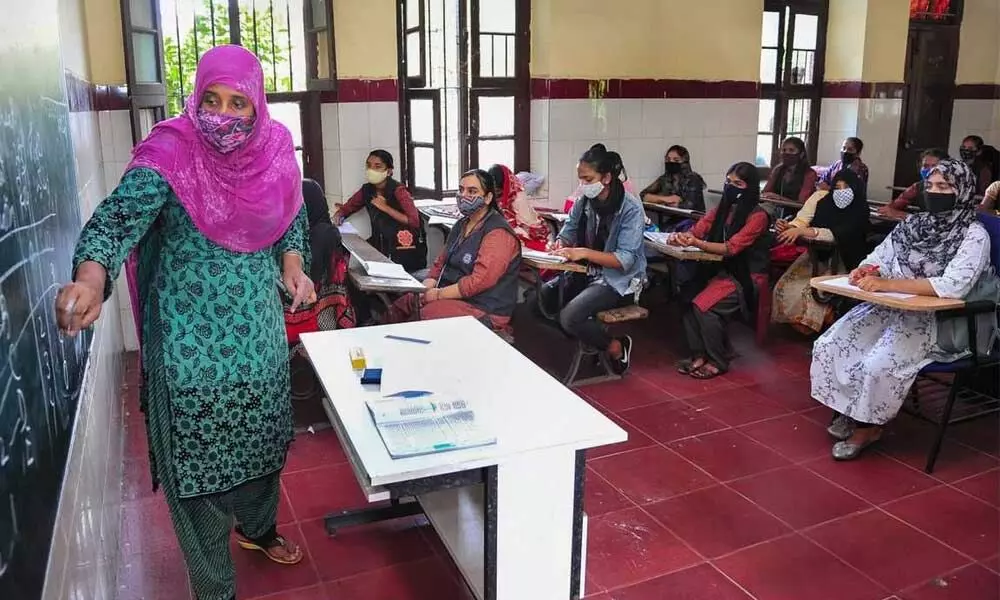Reopening of varsities needs greater precaution

Reopening of varsities needs greater precaution
In the wake of the novel coronavirus pandemic, uncertainty hovers
In the wake of the novel coronavirus pandemic, uncertainty hovers. One of the major shifts that have occurred in the past few months is that educational institutes have quickly moved to an online model of teaching and learning to ensure continuity. While online education has helped us during these difficult times, it has its limitations.
Collaborative learning, that is important has been impacted, and not only students, but teachers are also experiencing a great deal fatigue. The low level of engagement hinders learning for the students and they also experience boredom. The teachers, on the other hand, are not only challenged by technology but also have to continually think of innovative ways to keep an online class engaged.
Students need to get back to their campuses and UGC has already set down guidelines for reopening. Residential universities across India are gearing up to reopen by taking precautionary measures for the safety and wellbeing of students as they return to their campus. Major questions that we need to address are: How do you prepare for the return of students, faculty and staff to your campus? Once they arrive, how will you manage your residence halls, dining halls, classrooms, and offices, and serve your mission in a challenging fiscal environment?
Our immediate priority should be to build a roadmap for the campuses that ensure proper sanitisation at every corner while keeping social distancing in mind. These new practices will encompass myriad of issues beyond social distancing, including use of protective gear, cleaning protocols, classroom management and campus visitor screening protocols. In whatever we do for safety of students, faculty and staff should be of prime concern.
'Appropriate Covid-19 behavior', that includes wearing masks, washing hands frequently with soap and maintaining social distancing must be practiced at each juncture. One must ensure that all students and staff members know the common symptoms of infection as a precautionary measure for early detection.
To exercise adequate control and ensure comprehensive briefing of students, it would be advisable to let students return in a staggered manner, preferably 50% of each batch in one lot. Maintaining one-week gap between two batches will help in identification and management of any infection that may occur, while at the same time reducing the risk of follow up batches as well as attending to individual needs of each student. On arrival from their respective countries and States, it would be advisable for students to self-quarantine for 14 days in their individual rooms. This will ensure that chances of Covid-19 infection from new arrivals and intra-batch/group infections are almost eliminated.
It would be a good idea for Institutions to assume this responsibility. A travel advisory outlining how to prepare for travel and in-travel precautions could be shared with students and their parents to ensure that students' reception arrangements are done as per their convenience, as they leave their homes in such uncertain times. Handholding by institutions could include obtaining travel details in advance and organising transport facilities with sanitisation and segregated driver seats for student's safety. Upon arrival, one needs to make sure that students are carrying the necessary precautionary tests with them such as RT-PCR test.
Universities could limit occupancy in lecture halls to allow adherence to physical distancing norms. It will require 'hybrid mode' of delivery of the learning process after dividing sections/groups into two; one group in face-to-face interaction in classrooms and the other in hostel rooms; changing places on alternate days. Another approach could be a 'flipped classroom' where the faculty records and shares lectures in advance followed by discussion sessions and short quizzes in smaller groups. This may require extended class hours every day and six days engagement in a week.
It should be ensured that ample and easily accessible hands-free sanitisation stations are placed at the entrance of every building and all corridors for maximum utilisation by all. Norms to sanitise before entering the classroom and after leaving should be strictly implemented. In addition, all classrooms and labs should be specifically sanitised after each session.
To prevent entry of any infected person to the campus, a pre-arrival test by each returning student, faculty and staff should be the start point of testing protocol. This will eliminate entry of infected persons into the campuses except for the travel component. A combination of protocols for subsequent testing could be followed thereafter. One recommended process is to test all after 7-8 days of joining the campus and repeat the same two weeks after the first test. This will cover both self-quarantine and post quarantine periods. Subsequent testing could be as an outcome of daily health checkup. Daily health checkup may consist of temperature check, SPO2 level check and monitoring of other ILI symptoms.
While students are away from home, attention needs to be paid to provide them with nutritious food in designated messes and create options for obtaining the same from other points of sale. Given the challenge of managing adequate distancing and constant sanitation in large dining halls, universities should re-appropriate the dining spaces to cater to these requirements. In the quarantine period, it should be managed through delivery of all meals only in their respective rooms. Other approaches include staggering the timing batch-wise to avoid crowding, spaced seating and proper hygiene, sanitization, daily health check and appropriate kitting of the mess staff.
One of the biggest challenges faced by the universities would be control and management of students in their residential areas. Involvement of students and making it a student-led process is likely to yield best results. While security and admin teams may assist the wardens in this process, 'Students Safety Squads' could provide the best shield. Wherever possible, students should be housed in a single room occupancy and should consist of detailed procedure for disinfection and cleaning of rooms, of washrooms and common areas.
Getting students back to campuses should not create a feeling of deprivation from social and cultural engagement. It is equally essential to create opportunities to enable students to undertake physical and cultural activities which are a must for their psycho-social wellbeing and development. For some time to come Covid-19 may restrict activities like swimming and team games, one can indulge in individual sports like badminton, tennis, table tennis, apart from activities like jogging, running, yoga and walking, which can be done with very little effort and precautions. It would certainly require monitoring and sanitisation of equipment after individual use. As the situation improves other sports and social activities may be commenced.
There is only so much that the administration can do, and students would have to make a conscious effort for their safety as well as well-being of their peers. Maintaining social distancing, wearing a mask, ensuring proper sanitisation, and motivating their peers and subordinates to do the same may be the only way to keep the infection at bay and ensure safety of the campus communities at large.
The new normal is here to stay. Safe reopening for the education sector requires all of us to work together, employing the recommended best practices and maintaining safe daily habits to reduce the risk of exposure to Covid-19 and return of students to their second home.
(The writer is Chief Operations Officer & Dean, Student Affairs, NIIT University. Views expressed are personal)














